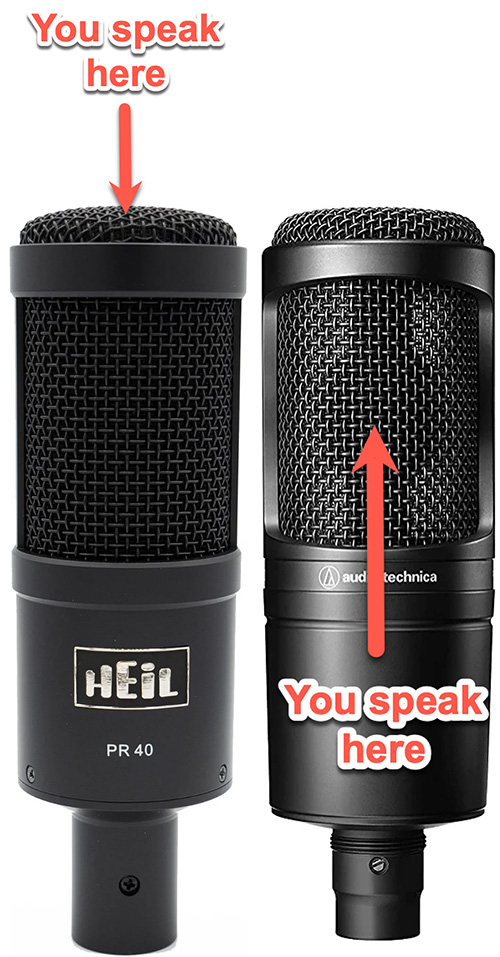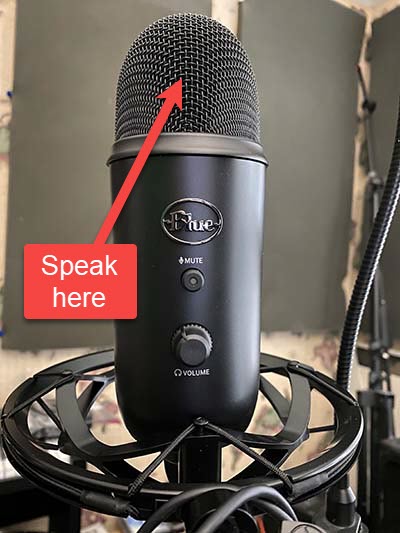What Part Of The Mic Do I Speak Into?
This is the 3rd post in a quick series I’m doing on how to make your podcast sound professional. To start at the beginning, see the first tip here: How To Make A Podcast Sound Professional, Pt 1.
And of course all of these tips apply to voiceover, video and audiobook recording as well.
So far I’ve mentioned how much better it will sound if you get your mouth super close to the mic, and then make sure you are recording at a high enough level, but not TOO high.
This post is about what part of a microphone you speak into. Also I touch on what polar/pickup patterns are.
1. What is a multi-pattern microphone?
Some mics are “multi-pattern” mics. Depending on the model you buy, you’ll be able to switch between pickup (or polar) patterns called cardioid, bidirectional (figure-8), and omnidirectional patterns.
Generally speaking, you won’t be needing bidirectional or omni patterns for podcasts. This is especially true if you have not treated your room with acoustic panels – or at least soft blankets – to reduce room reverb.
It might be tempting to use a bidirectional mic if you have 2 people. You could put it between them as they sit across from each other. But this will also make any room reverb much louder.
The same is true for the omni setting, which picks up sound from every direction. In fact room reverb would be even worse with this setting.
So while theoretically, it might make sense to use a single mic for multiple people – host and guests in the same room – this only is practical if your room is acoustically treated.
2. Use a cardioid microphone or cardioid setting on a multi-pattern mic
Cardioid microphones or cardioid settings on multi-pattern microphones are a great way to make your podcast sound more professional. Cardioid microphones, which are designed to pick up sound from the front and reject sound from the rear, are ideal for recording podcasts, as they help to reduce background noise, room reverb, and isolate the podcast’s audio.
If your microphone has a multi-pattern setting, it may also have a cardioid setting, which will provide the same benefits as a dedicated cardioid mic. Additionally, cardioid mics are usually more affordable than multi-pattern mics, making them an attractive option for podcasting on a budget.
3. Speak into the correct side of the microphone
This may seem obvious, but it is SUCH a common issue. Make sure you’re speaking into the correct side of the microphone!
Large diaphragm condenser mics, which I highly recommend for recording voices, are symmetrical – either sort of flat with 2 obvious “sides, or like cylinders with no obvious “side” at all. The side of the microphone with the logo or label is almost always the side you should be speaking into.
If you speak into the wrong side, your mic can actually reject the sound of your voice! It will sound really bad. See the video below.
Another source of confusion on where to speak into a mic is whether it is the end or the side of the mic. In the past, if it was a large diaphragm condenser mic, it was pretty much always the side. But mics for podcasts lately can look almost identical, but one kind is “end-address” (speak into the end like a stage mic) and the other might be “side-address.”
Take a look at these two mics. The one on the right is a common mic used for vocals – the Audio-Technica AT2035. It is a side-address mic. But the one on the left, becoming more popular for podcasting, is the Heil PR40, which is an end-address mic. No wonder it can be so confusing!

A common issue with the Blue Yeti mic
The popular USB mic called the Blue Yeti sounds quite good. But it can be confusing on many levels. It is not only a multi-pattern mic, but the top is a half-dome. So it doesn’t have any “sides,” per se.
You do NOT speak into the end/top of this mic, like so many stock photos show. You speak into the side, just above where the “Blue” logo is. Here is where you speak into this mic.

See more about how to make the Yeti sound great (including how to select the cardioid pattern) in my post, Quickly Improve The Audio Quality Of The Blue Yeti.
To sum up
So in addition to getting your mouth close to the mic and recording at a strong/high enough level that won’t distort, you can make your audio sound even better by speaking into the correct side/end of a mic. Also, use a cardioid mic (or pattern on a multi-pattern microphone).
